PUCON (AFP) - A volcano in southern Chile erupted early Tuesday, spewing fiery plumes of lava into the night sky and forcing the evacuation of some 3,600 people from nearby towns.
In its first major eruption in 15 years, the Villarrica volcano, one of Chile's most active, began spewing lava and ash around 3am (2pm Singapore time), prompting authorities to declare a red alert, the National Emergency Office said.
As sirens sounded, bright yellow-orange lava spewed from the volcano about 800km south of the capital Santiago.
A column of ash rose as high as 3km above the volcano, which is about 2,800m high.
Authorities closed roads leading to the area as residents streamed into shelters at designated safe zones well removed from the volcano.
But within about seven hours the eruption calmed, and there were no longer any visible signs of activity.
"It's an active volcano, but at this point it has calmed down," said President Michelle Bachelet after flying into the region for an emergency meeting with local officials.
Bachelet held an early-morning meeting with the country's emergency committee in Santiago before travelling to the affected area, flying over the volcano along the way.
She declared an "agricultural emergency" for part of the region, enabling local governments to access national emergency funds to deal with the effects of the eruption and a drought gripping the area.
Once the eruption died down, authorities partially lifted their red alert, keeping it in place for a 10km radius around the volcano but allowing residents of the main towns in the area to return home under "yellow alert."
But schools remained closed in the towns of Villarrica, Pucon, Curarrehue and Conaripe, which surround the volcano.
POPULAR TOURIST SPOT
The eruption "was fairly intense but short in duration," said Luis Lara, the head of Chile's volcano monitoring network.
"It was basically a small eruption," he said from the National Emergency Office's headquarters in Santiago.
He downplayed the risk of widespread flooding, which sometimes occurs when lava melts the snow cover around a volcano, causing the surrounding rivers to rise.
But about 45 families were stranded in one community after a swollen river washed out a bridge.
Officials classified the eruption as level two on a scale that runs from zero to eight.
It was less intense than the 2011 eruption of Caulle, another volcano in southern Chile that spewed ash so high that it was visible across the continent in the Argentine capital Buenos Aires.
Villarrica is considered one of the most active volcanoes in South America, and draws crowds of tourists each year, with hikers climbing its slopes in the summer months to peer inside its crater.
Its last major eruptions were in 1984 and 2000.
It had shown signs of activity in recent weeks, registering minor explosions and emitting ash.

